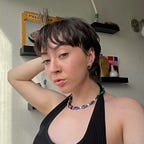Digital 3D Model: Wearable fact checker
My second iteration of an IoT device to combat political misinformation
Before watching the final presidential debate, my housemates and I joked about playing a drinking game in which every time a candidate lied, we’d take a shot. After the debate, I was curious about how many times that would have actually been. As it turns out, we would’ve ended the debate at least 22 shots in (according to Politifact’s post debate coverage), and most likely in the hospital. But—without live fact-checking technology, we wouldn’t have been able to play this game even if we had wanted to. Again, I wished there was a way to provide this info to the audience in real-time.
For my first project, I responded to this design challenge with an analog prototype of a fact-checking tie. After user testing and receiving feedback from my peers, I decided to iterate further. For this project, I made a 3D model of a wearable fact-checking clip.
Design
During a critique session for my first iteration, my peers pointed out a flaw in my design: a tie is not gender inclusive. I was aware of this flaw from the beginning, but hadn’t yet considered alternatives. Taking feedback from my peers, I decided to simplify my design to a fact-checking clip. I prototyped this design using Onshape, a 3D computer-aided design tool. The clip has the same main components as my tie: a mic, a power switch, and an LED light. It can be attached to any item of clothing; for candidates, this would likely be a dress coat or blazer.
During the debate, it would upload audio to an external fact-checking program and determine the validity of the candidates’ statements within milliseconds. The LED light would then respond to the determination of the program by turning green if the statement is true, red if it’s false, and orange if it’s partially true or partially false.
Prototype
Starting out on Onshape, I was perplexed by the unfamiliar tools on the software. After reading articles and watching tutorials, I slowly began to figure out how to bring my idea to life. I began with the body of the clip, which is a 2 x 1.5 x .5" rectangular prism. Next, the LED light. This component ended up taking the most of my time to create, since Onshape does not offer a “dome” tool. With a few workarounds, I was able to create a round LED on the face of the clip. On the side of the clip, I punched out rows of holes for the mic, which would face the candidate’s mouth, and added a power switch. Lastly, I added two extruding arms to the back of that can be bent and affixed to an item of clothing. I loosely based this component off of the design of lavalier clip microphones.
Analysis
If I had time to continue to iterate on my 3D model, I would put more consideration into the size of the clip. While designing on Onshape, I took a guess at the proportions of the body of the clip. I aimed to make it small enough to not weigh down the candidates clothing, but conspicuous enough to catch the attention of the audience. The only way to figure out the correct sizing would be to test my design in real life. If I had extra time, I would have 3D printed my model and done just that. By trying it out on a user and recording them in the same manner as typical for debates, I would be able to test out the visibility of the LED light.
Additionally, I would spend more time on the actual “clip” function of the model. I imagined this component would be bendy and adjustable to the thickness of the garment it attaches to. Although roughly based off of the design of lavalier microphones, I wasn’t able to fully replicate the alligator-like clip attachment with my limited CAD skills. If I had more time, I would look into the tools I could use to achieve this shape. With a 3D printed model, I could have also tested out the functionality of the clip on a user, and improved based on my findings.
